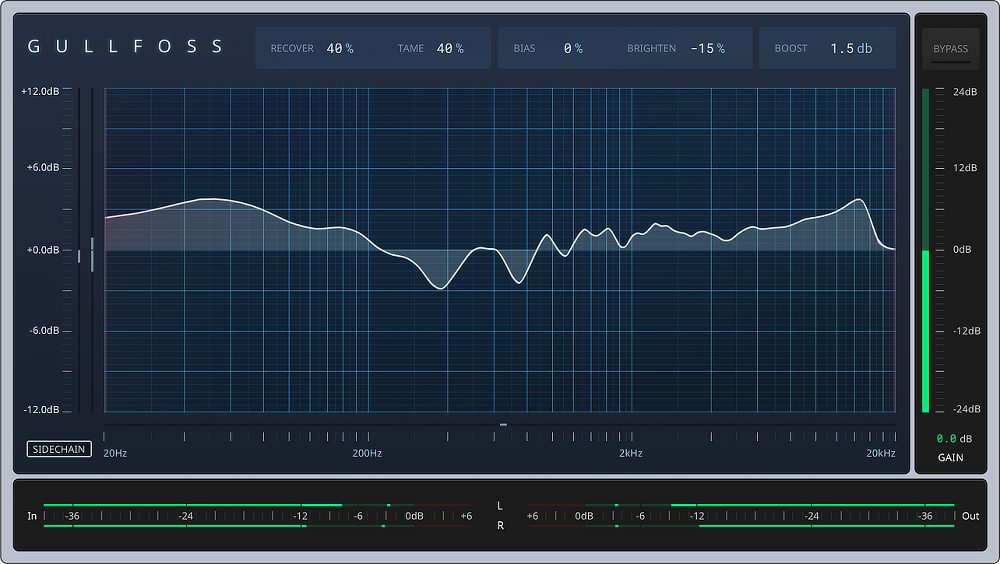Gullfoss by SoundTheory Review
Introduction
Whether you are an experienced mixing engineer or a beginner who is still wondering what you should do next in terms of mixing, having a plugin with very few controls but a lot of impact on the signal is a welcomed software for everyone.
Well, the Gullfoss plugin by SoundTheory is that kind of plugin. In essence, this is an intelligent EQ plugin that makes adjustments to the signal by itself, meaning that it applies the best possible curve for the signal you have at hand.
So let’s double-check the 5 parameters that you have at your disposal to instruct how the plugin should work.

- Gullfoss’ most important parameters, Recover and Tame, deal with components that have been dominated and those that have not. A recovery emphasizes the dominant aspects, whereas a tame counteracts those aspects. More energy equals dominance in general, as we can verify in practice. It is possible, for instance, for a monophonic synthesizer bass line to take center stage, while ghost notes on the snare or other nuances can dominate a busy mix.
- For what Soundtheory calls “borderline cases,” situations that require the plug-in to decide which way to go, the Bias determines the relationship between “recover” and “tame.” A positive value indicates more recovery. Negative values, on the other hand, will place tame at the top of the priority list.
- The Brighten parameter is the easiest to use and is self-explanatory – turn it up for higher frequencies, turn it down for lower frequencies.
- The Boost function raises the low frequency and lowers the mid-frequency. It is used in conjunction with “brighten” to adjust the frequency balance.
- The output level meter is used to measure the clean output gain. In addition, there are horizontal input and output level meters on the lower portion of the interface and an action meter on the left, making it easy to see all the pertinent information at a glance.
Despite its simple user interface, this application appears to be very complex behind the scenes, as it uses a model based on human auditory perception. As a result of this model, the EQ curve of the signal being processed is adjusted dynamically to maximize clarity in accordance with the settings you have made and the nature of the input signal.
Gullfoss also appears to be able to counteract side effects associated with phase problems, such as smearing caused by minimum-phase EQs and multiple microphone configurations.
This plug-in features proprietary perception modeling as well as new precision equalization technology to eliminate artifacts when the EQ curve is modulated rapidly. In order to prevent audible ringing and overshoots, the EQ algorithm has been designed to minimize these effects.

According to the manual, Gullfoss aims for an optimum tone balance, and if your raw material seems to always add cut or boost at one part of the spectrum, you may need to adjust your EQ balance. You may need to adjust the Brightness and Boost controls slightly if the amount of high-frequency lift is slightly greater than you require with both controls set at neutral.
In addition to providing a natural-sounding sheen of clarity, it is also very effective in lifting out details in the mix. The sounds fill the space between instruments as if sonic fog is being pushed away. We find that the percussion sounds benefit greatly, as well as the overall mix coming into better focus on all levels.
Gullfoss’s simple interface and a limited number of controls make it easy to use and relatively easy to master. Users should become familiar with the parameters quickly. However, we found it to be a bit of a gamble because it may or may not work with the program material.
However, we will try to look at the bright side of the situation, which is that the plug-in will improve the material and that the road to achieving that will be without obstacles since it is very simple to understand and use.
In terms of price, Gullfoss has a fair price tag that is comparable to many of the EQ plug-ins available in the market, and if it elevates your setup, then it is totally worth the investment.
Conclusion
Gullfoss can be a valuable tool when it comes to improving a particular track on a mix or on a stereo bus when mixing or mastering. The end results may be satisfactory if you slap it there and play with the parameters.
We just want to point out to you to apply the effects of this plugin in places where you uniquely will think that it will improve the sound and not just put it because it sounded well on another signal. After all, use your ears and make decisions according to what you are hearing, since the plugin might become addictive to use.
If you are having any questions in regards to our topic here, please let us know in the comment section below, or reach out to Sound Theory website for more in-depth answers!






